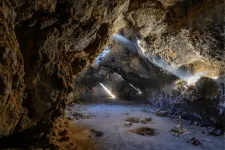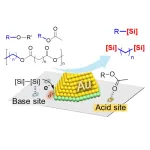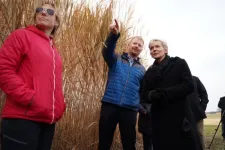(Press-News.org) University of Utah Health scientists have corrected abnormal heart rhythms in mice by restoring healthy levels of a protein that heart cells need to establish connections with one another. That protein, GJA1-20k, is underproduced in people with a genetic condition called arrhythmogenic cardiomyopathy, one of the leading causes of sudden cardiac arrest in athletes under the age of 35.
The finding, reported in the journal Circulation Research, suggests a new strategy for treating the abnormal heart rhythms caused by arrhythmogenic cardiomyopathy.
The results may also have implications for treating dangerous arrhythmias associated with more common conditions, such as those that can develop soon after a heart attack.
“This is really a new paradigm for the treatment of heart rhythm disorders,” says Joseph Palatinus, M.D., Ph.D., an investigator at the Nora Eccles Harrison Cardiovascular Research and Training Institute (CVRTI) and critical care cardiologist at Intermountain Healthcare. Palatinus is the first author of the study, which was led by U of U Health colleague Robin Shaw, M.D., Ph.D., director of the CVRTI.
An unusual pattern in patients
People with arrhythmogenic cardiomyopathy are born with normal hearts but begin to develop an irregular heartbeat in their 20s or 30s. These arrhythmias can raise the heart rate to dangerous levels and explain why some individuals with the condition experience sudden cardiac arrest during exercise.
Patients diagnosed with arrhythmogenic cardiomyopathy are advised to restrict exercise. They may also benefit from an implantable defibrillator to control their heartbeat. As the disease progresses, the heart muscle becomes fatty and fibrotic. This prevents the heart from pumping blood efficiently, and eventually patients need a heart transplant.
Palatinus, Shaw, and their colleagues studied heart tissue from patients with arrhythmogenic cardiomyopathy who underwent transplant and discovered a problem with a protein called Connexin 43. In healthy hearts, Connexin 43 forms channels between adjacent cells, facilitating communication. The diseased hearts made normal amounts of Connexin 43, but it wasn’t at the edges of cells where it belonged.
This, the team determined, was likely because there wasn’t enough of a trafficking protein, called GJA1-20ka. The researchers knew from previous experiments that without it, the heart’s cells wouldn’t be able to get Connexin 43 to the right place.
Fixing an abnormal heartbeat at the source
To determine if they could restore the heart’s normal rhythm, the scientists turned to mice that have similarities to people with arrhythmogenic cardiomyopathy. They both have low levels of GJA1-20k and develop arrhythmias. Palatinus and colleagues used low doses of gene therapy to bring the trafficking protein GJA1-20k back to normal levels. This, they confirmed, enabled heart muscle cells to transport Connexin 43 to its proper locations.
Most importantly, it gave the animals a more normal heartbeat. “The ease and low dose needed to fix the arrhythmias of even an inherited heart disease suggests that we have identified a critical pathway to stabilize cardiac electrical activity,” said Shaw.
Although arrhythmia improved, the animals still had heart scarring, a symptom from a different underlying condition. Palatinus noted that was actually an encouraging result. It suggests arrhythmia and heart scarring can occur independently and that it could be possible to treat abnormal heart rhythms even when the heart is severely scarred. “This is a new paradigm,” he says.
The treatment success in mice suggests that raising levels of GJA1-20k might restore normal heart rhythms in patients with arrhythmogenic cardiomyopathy, too. For patients, Palatinus says, it might be possible to deliver the therapeutic protein directly to the heart. Further research will be needed to develop the treatment for clinical use.
Disruptions in protein trafficking are thought to contribute to arrhythmias beyond those caused by arrhythmogenic cardiomyopathy, and Palatinus is optimistic that a similar treatment strategy might be useful for those conditions, too. If so, that could one day give patients and their doctors an alternative to the ion channel-blocking drugs currently used to treat many arrhythmias, which can slow the heart and even lead to new rhythm problems for some patients.
# # #
The research was supported by the National Institutes of Health, The Harold Geneen Charitable Trust, and the Nora Eccles Treadwell Foundation and published as “GJA1-20k Rescues Cx43 Localization and Arrhythmias in Arrhythmogenic Cardiomyopathy.”
About University of Utah Health
University of Utah Health provides leading-edge and compassionate care for a referral area that encompasses Idaho, Wyoming, Montana, and much of Nevada. A hub for health sciences research and education in the region, U of U Health has a $458 million research enterprise and trains scientists and the majority of Utah’s physicians and health care providers at its Colleges of Health, Nursing, and Pharmacy and Schools of Dentistry and Medicine. With more than 20,000 employees, the system includes 12 community clinics and five hospitals. U of U Health is recognized nationally as a transformative health care system and provider of world-class care.
END
Step forward in gene therapy to treat cause of sudden cardiac arrest in athletes
2023-03-18
ELSE PRESS RELEASES FROM THIS DATE:
Inmates with opioid addiction report peer navigators are crucial for successful community reentry
2023-03-18
Recently incarcerated people with opioid use disorder have trust in working with peer support specialists who recovered from addiction and faced similar life experiences, according to a Rutgers study.
The study, published in the journal Psychiatric Services, found that peer support specialists were most valued for providing emotional and community-based addiction recovery support as well as housing and employment information — crucial when going back into the community.
More than ...
Hansel and Gretel's breadcrumb trick inspires robotic exploration of caves on Mars and beyond
2023-03-18
House hunting on Mars could soon become a thing, and researchers at the University of Arizona are already in the business of scouting real estate that future astronauts could use as habitats. Researchers in the UArizona College of Engineering have developed technology that would allow a flock of robots to explore subsurface environments on other worlds.
"Lava tubes and caves would make perfect habitats for astronauts because you don't have to build a structure; you are shielded from harmful cosmic radiation, so all you need to do is ...
3D radar scan provides clues about threats to iconic Alaskan glacier
2023-03-18
A detailed "body scan" of Malaspina Glacier, one of Alaska's most iconic glaciers, revealed that its bulk lies below sea level and is undercut by channels that may allow ocean water to gain access, should its coastal barrier erode. This makes the glacier more vulnerable to seawater intrusion than previously thought and may cause it to retreat faster than predicted.
The findings, published by University of Arizona researchers in the Journal of Geophysical Research, underscore ...
Changes in mangrove blue carbon under elevated atmospheric CO2
2023-03-18
As one of the major blue carbon ecosystems, mangroves provide critical ecosystem services in mitigating global climate change. However, the future complex and variable climate conditions may lead to the uncertainty in trajectories of blue carbon capacity. Elevated atmospheric CO2 concentrations (eCO2) is projected to become a prominent driver to mangrove blue carbon in the future.
A group of scientists working on blue carbon reviewed studies on “changes in mangrove blue carbon under elevated atmospheric CO2” to identify the pathways for how eCO2 might influence mangrove ecosystem carbon cycling. The research is published as a review article in Ecosystem health and sustainability, ...
Study examines the link between mental health and oral health
2023-03-18
Alexandria, VA – A study examining the mental health-oral health association cross-sectionally and longitudinally was presented at the 52nd Annual Meeting & Exhibition of the AADOCR, held in conjunction with the 47th Annual Meeting of the CADR. The AADOCR/CADR Annual Meeting & Exhibition took place at the Oregon Convention Center in Portland on March 15-18, 2023.
The study, led by Alex Kalaigian of the University of California, San Francisco School of Dentistry, acquired self-reported data from the Population ...
New catalyst helps turn plastic waste into useful organosilane compounds
2023-03-18
Tokyo, Japan – Researchers from Tokyo Metropolitan University have found that gold nanoparticles supported on a zirconium oxide surface help turn waste materials like biomass and polyester into organosilane compounds, valuable chemicals used in a wide range of applications. The new protocol leverages the cooperation between gold nanoparticles and the amphoteric (both acid and base) nature of the zirconium oxide support. The result is a reaction that requires less demanding conditions, a greener method for upcycling waste.
Recycling is a big part of humanity’s solution to the global issue of plastic waste. Much ...
DOE funds next-generation Center for Bioenergy Innovation to advance renewable jet fuel
2023-03-17
The Center for Bioenergy Innovation has been renewed by the Department of Energy as one of four bioenergy research centers across the nation to advance robust, economical production of plant-based fuels and chemicals. CBI, led by Oak Ridge National Laboratory, is focused on the development of nonfood biomass crops and specialty processes for the production of sustainable jet fuel to help decarbonize the aviation sector.
The DOE announcement provides $590 million to the centers over the next five years. Initial funding for the four ...
DOE renews CABBI for five more years
2023-03-17
The U.S. Department of Energy (DOE) has committed another round of funding to the University of Illinois Urbana-Champaign to lead the second phase of its Bioenergy Research Center — one of four large-scale DOE-funded research centers focused on innovation in biofuels, bioproducts, and a clean energy future for the country.
Earlier today the DOE announced a five-year extension of funding for the Center for Advanced Bioenergy and Bioproducts Innovation (CABBI), to a total of $237.9 million for the period from 2017 to 2027. CABBI ...
Study attempts to identify bacterial indicator species of obesity and metabolic syndrome in adult and pediatric patients
2023-03-17
Alexandria, VA – A study aiming to identify biomarker species associated with obesity and metabolic syndrome (MetS) was presented at the 52nd Annual Meeting & Exhibition of the AADOCR, held in conjunction with the 47th Annual Meeting of the CADR. The AADOCR/CADR Annual Meeting & Exhibition took place at the Oregon Convention Center in Portland on March 15-18, 2023.
The study, led by Tanveer Vasdev of the University of Iowa, analyzed 208 saliva and subgingival samples from periodontally, healthy, frequency-matched patients belonging to adult and pediatric obesity and MetS. Bacterial ...
Aging | Senescence-associated exosomes transfer fibrosis to neighboring cells
2023-03-17
“This shows that SA-EXOs can serve as potent SASP mediators that activate invasive characteristics in neighboring cells.”
BUFFALO, NY- March 17, 2023 – A new research paper was published in Aging (listed by MEDLINE/PubMed as "Aging (Albany NY)" and "Aging-US" by Web of Science) Volume 15, Issue 5, entitled, “Senescence-associated exosomes transfer miRNA-induced fibrosis to neighboring cells.”
Radiation-induced fibrosis is a common side effect of radiotherapy, which is the most common ...





